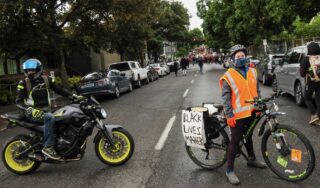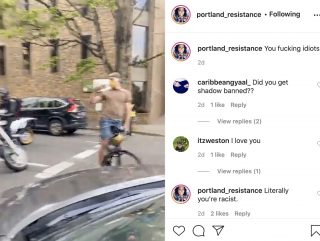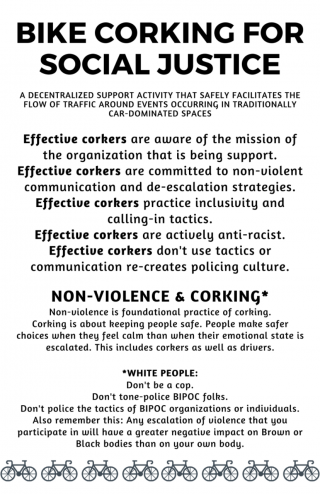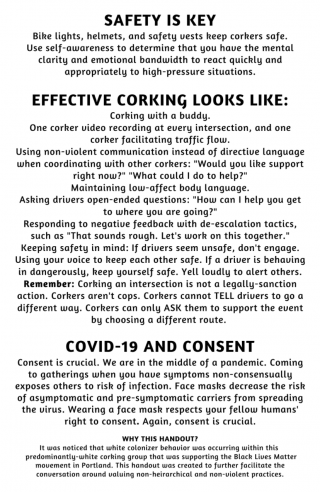
(Photo: Jonathan Maus/bikePortland)
For over a month now, Portlanders have been taking to the streets every night to protest the killing of Black people and the racist policies and police brutality that contribute to it.
At almost every march there’s been a cadre of two-wheeled escorts patrolling intersections, directing traffic, and doing whatever is necessary to keep protestors safe. “Corking,” the act of placing your bicycle and body in an intersection in front of crossing road users so that a large group of people can go through without stopping at signals and stop signs, has been a part of protests many years.
But not everyone knows the drills. And when tensions mount in the street, it’s good to know some basic ground rules — especially if you’re white.

In Portland’s recent protests these bike patrols have matured into well-oiled operations. They are working directly with protest leaders. There are group chats where plans are coordinated and pre-ride debriefings where volunteers get hi-viz vests, safety tips and specific assignments. While it’s been an inspiring show of solidarity and cycling acumen, there have been some challenges. One of them is that not everyone who shows up is well-versed in the necessary skills and best practices. The other is that the riders are mostly white. While it makes sense for white people to put their bodies in harm’s way to protect Black protestors, the outward appearance of a wall of white people at a Black Lives Matter protest can be awkward. And putting white people in positions of power at protests against white supremacy can be problematic.
At a march on Monday (6/29) near Portland State University to mark the two-year anniversary of the shooting of Jason Washington by campus police, a man in a car tried to get through one of the lines of corkers. In an Instagram post, the driver (who was Black) can be heard yelling at corkers (who were white) to let him drive through their blockade. After several tense minutes, they relented and let the driver through.
Advertisement
With big marches coming July 4th, bike crews are already planning for how to avoid incidents like that and make sure things go as smoothly as possible. To help educate volunteers, one group has created a flyer with instructions on, “Bike Corking for Social Justice.”
In addition to excellent tips on de-escalation and how to be an effective corker, there’s also information targeted directly at white people. Here’s what it says:
“Don’t be a cop. Don’t tone-police BIPOC folks. Don’t police the tactics of BIPOC organizations or individuals. Also remember this: Any escalation of violence that you participate in will have a greater negative impact on Brown or Black bodies than on your own body.”
One of the lead creators of the flyer is Amelia Bjesse-Puffin (on Instagram at @smash_the_skatriarchy). She felt it was necessary because she’d noticed “white colonizer behavior” among the group. She says the guide is a work in progress and that it was a group effort with other corkers she’s met at recent protests. “I’ve been corking for just a few weeks so I’m just adding what I can to the movement,” she shared with us via email.
If you want to help keep marchers safe, take a look at these flyers, find an upcoming event via the Black Lives Matter calendar and look for the riders in hi-viz vests.
For more cycling/protesting inspiration, don’t miss this great story published today by The New York Times, Thousands Join N.Y.C. Bike Protests: ‘It’s Like Riding in the Cavalry’
— Jonathan Maus: (503) 706-8804, @jonathan_maus on Twitter and jonathan@bikeportland.org
— Get our headlines delivered to your inbox.
— Support this independent community media outlet with a one-time contribution or monthly subscription.



